The True Cost of Fixed Infrastructure
Traditionally, the cost of warehouse infrastructure has been seen in terms of depreciation, fuel and electricity. While these costs are not irrelevant, the challenges brought on by the rise in e-commerce in regard to fluctuating demand and difficulties in predicting future growth is rendering some equipment costly to the point of inadequate.
As warehousing costs continue to grow due to increasingly complex warehousing scenarios, the cost of equipment must be seen in relation to its ability to flexibly cope with fluctuations in demand, labor shortages, higher rental costs for space as well as risk.
Off-peak season cost & fixed infrastructure
In the US, retailers generally experience an annual peak in business in November and December with companies claiming a 50%-to-100% increase in operations and others stating 75% of an entire year's revenue to be generated in this period. To handle two months heightened demand and logistics challenges, companies will prepare by building warehouse facilities months in advance.
Building for peak imply high costs as the infrastructure needed for handling two months of high demand won’t be fully utilized under the remaining ten months of normal demand. It does, however, imply twelve months of expenses for electricity, maintenance, upfront capital expenditure, and rental costs. Similarly, some may have to keep excessive labor for periods longer than necessary to secure skilled workers for operating equipment under short periods characterized by high demand.
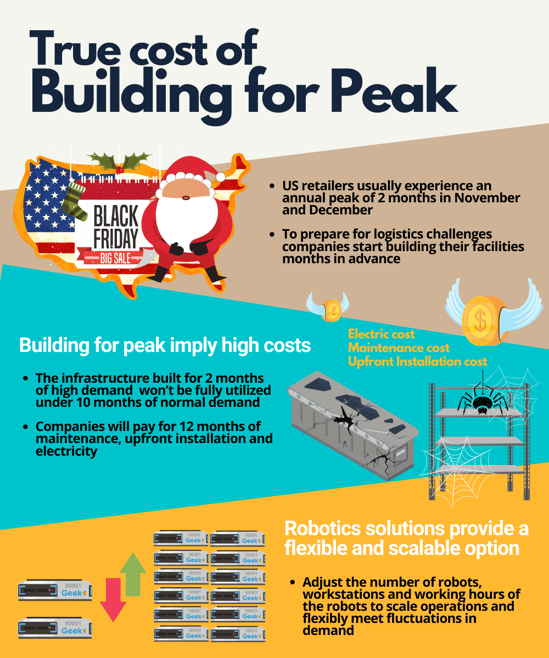
Labor-intensive infrastructure & Low-density storage
In a warehouse, the costs of infrastructure should be seen in regard to its effect on other factors driving warehousing costs i.e. labor and space. For example, conveyor belts require a lot of workers to secure consistent throughput and is therefore considered a relatively labor-intensive and expensive technology. To guarantee efficient operations, conveyor belts require workers to:
- - Ensure labels are faced correctly
- - Prevent jams
- - Manage damaged items
- - Support additional routes for non-conveyable items like bags, items 1 lbs, polystyrene packaging, and triangular or cylindrical packing tubes
Similarly, the infrastructure will impact space utilization and storage capacity in terms of aisle width and space needed for operating. As the rise of e-commerce and same-day delivery services continue to drive the demand for warehouse space closer to urban areas, it generates higher prices of industrial real estate, making low-density storage and wasted space an increasingly costly scenario.
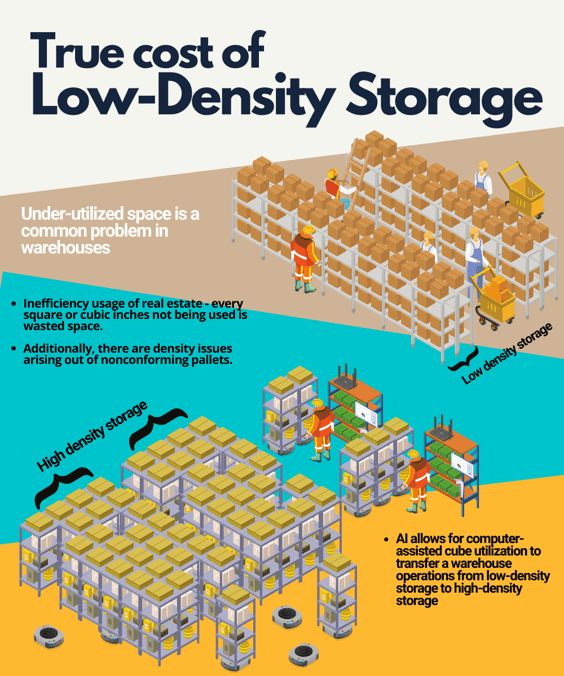
Cost of downtime & single-point-of-failure
Fixed infrastructure may also lead to expensive scenarios of closed large-scale operations and downtime due to single-point-of-failure. A gridlock caused by full lines on conveyors, excess recirculation or broken sensors, imply high costs for lost throughput as well as the equipment and skilled labor needed to clear jams or motor faults. Moreover, tagout or lockout procedures require additional downtime to prevent accidental or unauthorized access to equipment undergoing maintenance. Downtime is known to damage businesses dependent on perfect orders and fast deliveries for remaining competitive.
Moreover, in a report conducted by research firm Markets and Markets, the demand for conveyor monitoring services is expected to grow by 3.5% from 2019 to 2024 due to frequent maintenance issues, costly shutdowns, and the time-consuming and labor-intensive task of detecting failures.
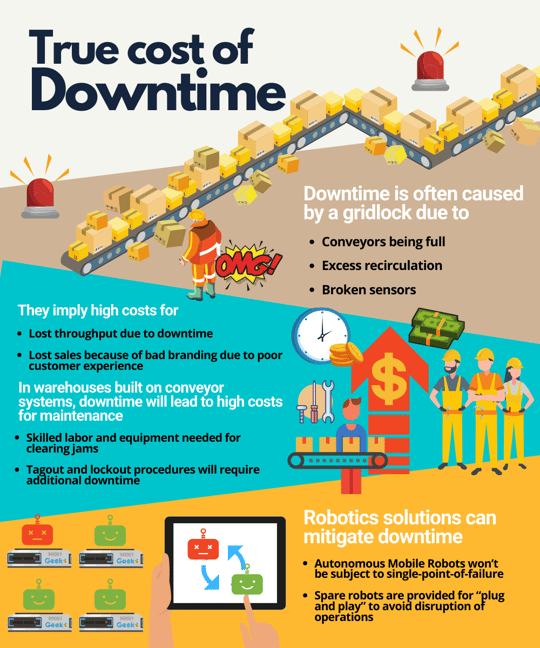
Warehouse infrastructure & labor safety
Lastly, some equipment may lead to costly accidents as a workforce often subject to either exhaustion or inexperience must operate difficult equipment. According to the US Bureau of labor statistics, 5% of the warehousing workforce will suffer from work-related injuries every year, a rate higher than the national average for all industries. Additionally, in a survey released in 2019, the second most frequent cause for overall occupational injuries in the US involved contact with objects and equipment, like employees getting caught in running equipment or machinery or being struck by falling objects or equipment.
Guaranteeing labor security in warehouses may be given a new meaning in the future as the ongoing pandemic has gotten industry leaders and decision-makers alike to consider what a post-pandemic warehouse might imply in terms of equipment that can ensure health and safety aspects and meet potential social distancing regulations.
The solution
Geek+ provides robotics solutions that solves the above-mentioned issues. By combining AI-driven Autonomous Mobile Robots and intelligent software, Geek+ provides customized solutions that support businesses with the flexibility needed for de-risking operations. The software can easily adopt new product mixes to mitigate fluctuating demand, and in terms of scalability, one only has to adjust the number of AMRs, workstations, and added hours to the day while the human factor remains unchanged. In turn, the systems enable businesses to avoid many of the costs associated with labor shortages, building for peak and having to invest in expensive and fixed infrastructure to meet growth underlying growth demands.
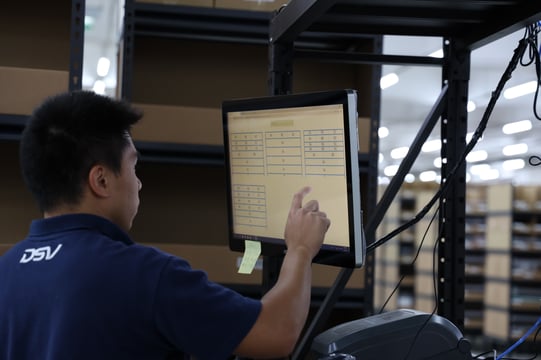
Geek+ robotics solutions will mitigate against risk. AMRs are interconnected through the Geek+ robot management system but move autonomously. If a robot stops working, spare robots are provided and can be easily deployed, avoiding risks for single-point-of-failure, widespread disruptions, and long downtime. Lastly, AMRs enable social distancing and lessen the risks for infection.
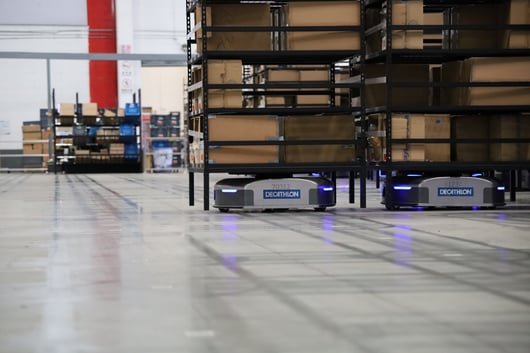
Geek+ and Nike introduce same-day delivery to Japan
In February 2020 – Geek+ empowered Nike with smart solutions enabling same-day delivery in Japan. By deploying more than 200 robots from its goods-to-person P series line, Geek+ was able to help Nike mitigate labor shortages and high labor wages while enabling the company to meet the rapid growth in their e-commerce sales and high expectations for same-day delivery.
Geek+ also took its after-sales support to a new level. In addition to guaranteeing safe implementation and maintenance of AMRs, Geek+ and Nike continued to cooperate throughout March to further maximize the productivity of AMRs in its warehouses and help the company continue to meet underlying growth demands. By assigning a consultant for carrying out an in-depth analysis of customer site and managing the analysis-proposal-execution-verification sequence while working with the customer, Geek+ improved overall productivity of Nike’s operations with a factor of 1.8.
The true cost of infrastructure should not be reduced to a matter of depreciation, fuel, and electricity, but seen in terms of its capacity to mitigate fluctuations in demand, labor shortages, and higher expectations for fast and accurate deliveries. Geek+ is committed to equip businesses with customized solutions where efficiency and flexibility are no longer considered opposites, but rather, two sides of the same coin.
If you want to know more details, you may download the whitepaper of Flexible v Fixed Infrastructure:
About Geekplus
Geekplus is a global leader in mobile robotics technologies. We develop innovative robotics solutions for order fulfilment. More than 770 global industry leaders use our solutions to realize flexible, reliable, and highly efficient automation for warehouses and supply chain management.
Media Contact
Marie Peterson, VP International Marketing & Communications
Marie.peterson@geekplus.com

